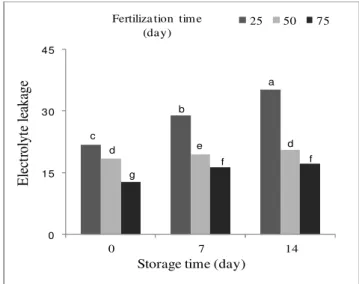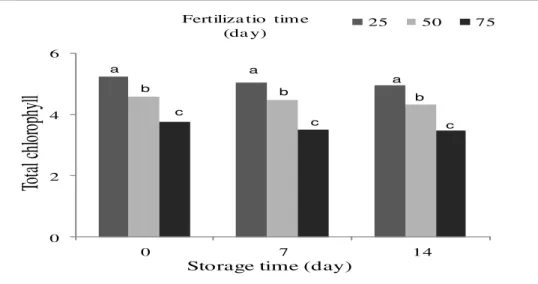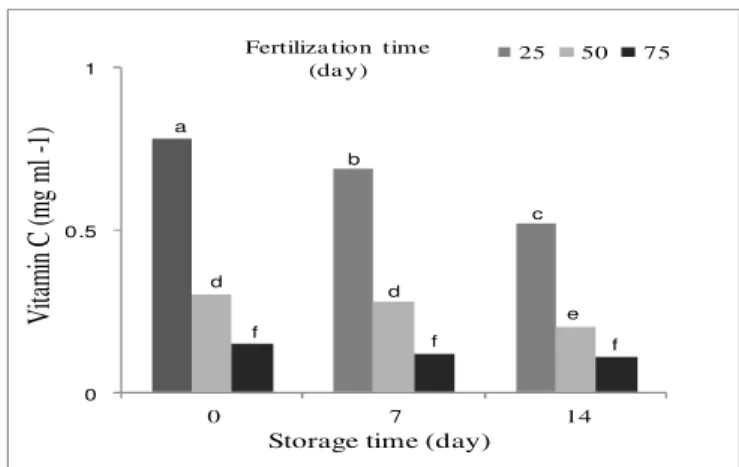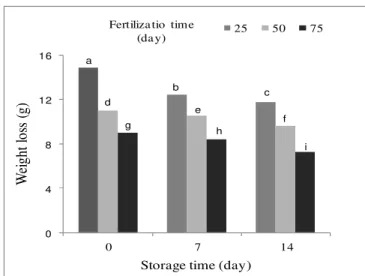Vol-7, Special Issue3-April, 2016, pp235-243 http://www.bipublication.com
Research Article
Effect of Different N Fertilization Times on Post-Harvest
Quality of Spinach (
Spinacea oleracea
L.)
Leila Bandian1, Hossein Neamati1 and Mohammad Moghaddam1
1 Department of Horticulture,
Faculty of Agriculture, Ferdowsi University of Mashhad, Iran. Correspondence: Hossein Neamati, E-mail: hosseinneamati200@gmail.com,
nemati@um.ac.ir. nemati@um.ac.ir.
ABSTRACT
The present study was conducted to evaluate the effects of urea fertilization times on postharvest quality of spinach. For this purpose, a pot factorial experiment in the context of randomized complete block design with four replications was carried out. Treatments include three fertilization times (25, 50 and 75 days after sowing) and measurements of chlorophyll, vitamin C and, carbohydrate content as well as, weight loss and electrolyte leakage were performed on 0, 7 and 14 days after harvest. Results showed that urea fertilization on 25 days after sowing has the highest effect on post-harvest quality. Significant chlorophyll reduction was observed after 14 days of storage. The highest chlorophyll content at harvest and fertilization times was observed 25 days after sowing. Nutritional
value (measured as vitamin C content ) and market quality (chlorophyll content) were highest at harvest time and
decreased during storage period. Total vitamin C significantly decreased after 14 days at the third times of fertilization (75 days after sowing). Carbohydrate content, weight loss and electrolyte leakage significantly decreased after 14 days of storage; so that the highest rate of carbohydrate and electrolyte leakage was observed at 14 days after the harvest and urea fertilization time as 75 days after sowing.
Keywords: fertilization, post-harvest, nitrogen, Spinacea oleracea, quality.
1.INTRODUCTION
Fertilization represents an important and even necessary practice that is widely used by farmers and vegetable growers to compensate soil nutrient loss and enhance crop yield (Rettke et al., 2006; Chintala et al., 2012). Nitrogen is one of the principal nutrients which needed for crops and hence, its deficit in soil has negative consequences on growth and development of crops. Therefore, fertilization with N is a popular horticultural practice extensively applied all around the world (Anjana, 2007). In fact, nitrogen is the most commonly applied nutrient in orchard crops and normally applied at higher rates than most other nutrients (Wells, 2013). However,
great importance to implement an efficient nitrogen management system that determines the optimal N fertilizer rate applied in the farms (Pahlmann et al., 2016; Chintala et al., 2013). Considering this paradox, a major challenge for the researches and producers is to sustain global food security and, at the same time, to minimize the negative impact of N fertilizers on the environment.
Another aspect of fertilization that possesses great importance in horticulture is its potential contribution in postharvest characteristics of vegetables and other freshly used crops. Indeed, it has been reported that fertilizers may affect vegetable appearance, texture and taste (Havlin et al., 2005). Postharvest properties of horticultural crops which control storage potential have been also reported to be affected by fertilization because they affect crop susceptibility to mechanical damage, physiological disorders, and decay (Wang, 2003).
Spinach (Spinaceaoleracea L.) is one of the most important leafy vegetables from Chenopodiaceae
family which represents an important source of minerals. It is a leafy cool season vegetable that produces a rosette during the vegetative stage (Kansal et al., 1981). Leafy vegetables are important part in the human diet that are used as a main source of vitamins, minerals and other bioactive compounds (Anjana et al., 2007). Spinach has low calorie and contains considerable amounts of vitamins A, C and minerals especially iron.
However, it is a highly susceptible vegetable and various postharvest conditions can affect its quality and marketability (Hodges & Forney 2003). Spinach is a leafy crops and therefore, its marketability highly depends on freshness and turgidity of its leaves. However, many properties of spinach which is making it acceptable by customers are lost quickly during postharvest practices (Grozeff et al., 2010). The loss of turgidity, carbohydrates, chlorophyll and antioxidants such as vitamin C are among the
characteristic changes taking place during postharvest periods (Ferrante et al., 2007). Therefore, it has been a major challenge for farmers and horticulturists to postpone these senescence-related traits to extent spinach availability in marketplace.
Regarding to the importance of postharvest traits of spinach leaves in marketability of the vegetable and considering the effects of N fertilizers on physiological properties, texture and appearance of leafy crops, the present study was carried out to investigate the influence of various N fertilization times on postharvest properties of spinach. To get a closer vision on the effect of N fertilization times on postharvest traits, four indices including electrolyte leakage, chlorophyll, carbohydrates and vitamin C content were evaluated under the fertilization regimes.
2. MATERIALS AND METHODS
2.1 Plant Material and Sample Preparation
The experiment was carried out in the research greenhouse of Ferdowsi University of Mashhad as a pot factorial experiment in the context of randomized complete block design with four replications in 2014. Mean minimum and maximum temperatures in the greenhouse were 15 and 26 °C, for the winter crop.
The treatments included urea fertilization times (25, 50, 75 days after sowing; at the rate of 200 kg/ha which is equal to 0.2 g soil (topsoil farm) per pot, and post-harvest times (0, 7, 14 days after harvest). The harvest time was determined when the control parcel’s plants reached to 4-5. leaves per plant and the harvest were done by hand.
2.2 Processing, Packaging and Storage Conditions
re-measurements were carried out on 0, 7 and 14 days.
2.3 Electrolyte Leakage Determination
Electrical conductivity measurements were performed as described by Blum and Ebercon (1981). The electrolyte leakage was calculated by the following equation.
EL = (Ci/Cs )×100
2.4 Total Carbohydrate Determination
3 ml of anthron indicator was added to the prepared samples at this stage and then they were boiled at 100 °C for 60 minutes (Hedge and Hofreiter, 1962).
2.5 Chlorophyll Content Determination
The total chlorophyll content of the leaves was determined by the method of Arnon (1949). based on acetone extraction of the chlorophyll and colorimetric assay with the aid of a Spectrophotometer Model JENWAY 6305.
2.6 Vitamin C Determination
1 g of fresh plant tissue samples were dissolved in 3 ml of 1% metaphosphoric acid solution, and samples were centrifuged for 15 minutes at 600 rpm. 0.5ml of dichlorophenol indophenol was added to each sample and absorbance rate was read at 500 nm (Institute of Standards and Industrial Research of Iran No. 56098).
2.7 Statistical Analysis
The statistical analysis of the data was performed using SPSS16.0 software for mean comparison based on least significant difference (LSD) test (p<0.05). Graphs were drawn by Excel software.
3. RESULTS AND DISCUSSION
According to the results of this study, significant differences were observed between the electrolyte leakage records during storage (Figure 1). These differences were more apparent at the end of the storage period where the electrolyte leakage increased twice as muchfor samples, compared with the initial values.
The highest electrolyte leakage was observed at day 14 and fertilizing 25 days after sowing (Table 1, Table 2). Electrolyte leakage was the lowest in
spinach exposed to late fertilization notably at the end of the storage period (Table 1).
g
e c
f
d b
f d
a
0 15 30 45
0 7 14
E
le
ct
ro
ly
te
le
ak
ag
e
Storage time (day)
Fertiliza tion time (day)
25 50 75
Figure 1. Electrolyte leakage in spinach at harvest and after storage in relation to the urea fertilization time.Means followed by the same letter do not differ
by LSD test at p≤ 0.01.
Table 1. The mean values of influence urea fertilization time on quality of spinach
Fertilization time (day)
Chlorophyll a
Chlorophyll b
Total chlorophyll
Weight loss (g)
Electrolyte leakage
Carbohydrate (µg ml -1)
Vitamin C
(mg ml -1)
25 50 75
3.31 a
3.28 a
3.13 a
1.22 a
1.26 a
1.20 a
4.60 a
4.53 a
4.33 a
12.59 a
9.91 b
9.80 b
37.98 a
24.03 b
16.98 c
0.079 a
0.080 a
0.079 a
0.37 a
0.34 b
0.37 a
Means that differ significantly within columns are followed by differ letters by LSD test at p≤ 0.01.
In the present experiment, loss of the chlorophyll content was observed in spinach. The lowest chlorophyll content was observed on 14 days after harvesting and the last fertilization time (Figure 2, Table 2). Since greenness is an important trait in leafy vegetables, reduction of chlorophyll concentration lowers marketability of spinach. On the other hand, the highest chlorophyll content was obtained in the first urea fertilization time (on the 25th day) indicating that this fertilization time is ideal for retention of chlorophyll content and leaf greenness (Table 1). This finding is in accordance with the results reported by Gutierrez-Rodriguez (2012) who showed that post-harvest nutritional quality and shelf life of spinach is significantly reduced when cultivated at high rate of nitrogen concentration.
Table 2. The mean values of influence storage time on quality of spinach
Storage time (day)
Chlorophyll a
Chlorophyll b
Total chlorophyll
Weight loss (g)
Electrolyte leakage
Carbohydrate (µg ml -1)
Vitamin C
(mg ml -1)
0 7 14
3.48 a 3.28 a 2.96 b
1.59 a
1.05b
1.04 b
5.70 a 4.50 b 4.00 c
12.18 a
10.41 b
9.35 c
15.24 c
19.49 b
30.26 a
0.75 b 0.80 a 0.82 a
0.70 a 0.22 b 0.12 c
Means that differ significantly within columns are followed by differ letters by LSD test at p≤ 0.01.
The loss of chlorophyll at both storage temperatures was not affected by N application rates between 140 and 260 mg l-1, thereby improving the retention of visual quality, as also indicated for broccoli inflorescences (Dan et al., 2005). Among various aspects of tissue decay, color is a very important determinant that influences consumer choice (Ferrante and Maggiore, 2007). Greenness of leafy vegetables is due to chlorophyll pigments that quickly undergo degradation during postharvest and storage period (Nisha et al., 2004).
c
b a
c b
a
c
b a
0 2 4 6
0 7 14
To
ta
l c
hlo
ro
ph
yll
Storage time (day)
Fertiliza tio tim e (da y)
25 50 75
Figure 2. The concentration of total chlorophyll in spinach at harvest and after storage in relation to the urea
Leaf discoloration is attributed to degradation of the leaf pigments or tissue browning. These physiological processes occur when cell membranes lose their integrity and release enzymes, which come into contact with their substrates, generating postharvest disorders (Jacxsens et al., 2002). Internal qualities such as antioxidant components are also important for human health because of their nutritional value. Chlorophyll and carotenoids are tightly correlated with each other because the latter protects the chlorophyll from photo-oxidation during growth (Biswall, 1995). This phenomenon has been observed in many leafy vegetables. It is known that the chlorophyll content of leafy plants such as chicory, Swiss chard and valeriana lettuce (Ferrante and Maggiore, 2007) decreases during storage.
The vitamin C concentration was highest at harvest time and decreased with urea fertilization close to harvest time (Table 1, Table 2). Moreover, vitamin C concentration declined during storage, so that the lowest content of vitamin C was observed at 14 days after harvesting and the last urea fertilization time (Figure 2). Vitamin C content was reduced as storage duration increased. This can be attributed to the structure of ascorbic acid that is gradually oxidized under poor storage condition, and hence, results in reduction of nutritional value of the crop (Chumillas et al., 2007). Vitamin C is a critical part of the plant defense systems (Hodges and Forney, 2003). It has been reported that higher ascorbic acid content in spinach is associated with better visual quality during storage (Bergquist et al., 2006). Vitamins are a class of organic compounds required in the human diet for normal physiological functions; and their unavailability in the diet causes vitamin deficiency diseases. Leafy crops, especially when consumed fresh, provide a valuable source of vitamin C for the human diet. Ascorbic acid is sensitive to destruction when fruits and vegetables are subjected to adverse postharvest
handling and storage conditions (Lee and Kader, 2000). The vitamin is vulnerable to chemical and enzymatic oxidation, highly water soluble, and is a sensitive and suitable marker for monitoring quality change during postharvest practices (Morrison, 1974).
a
d
f
b
d
f
c
e
f
0 0.5 1
0 7 14
V
ita
m
in
C
(m
g
m
l
-1)
Storage time (day) Fertiliza tion time
(da y) 25 50 75
Figure 3. The concentration of vitamin C in spinach at harvest and after storage in relation to the urea fertilization time. Means followed by the same letter
do not differ by LSD test at p≤ 0.01.
flavor component in many vegetables, producing a distinct sweet taste. The balance between storage and soluble carbohydrates within a tissue can affect vegetable quality. Starch is a major source of carbohydrate that, when degraded, contributes to sweetening of certain vegetables. Conversely, biosynthetic reactions can detract from sweetness. Starch metabolism during postharvest handling can have a significant effect on vegetable quality. In most harvested crops, decreased starch content results in increased sweetness. In leafy vegetables with a strong dynamic capacity to interconvert starch and soluble sugars, over- or under-accumulation of starch is rarely a quality problem (Schaffer and Petreikov, 1997). Few studies have been conducted on carbohydrates content of vegetables during storage. The increase in total sugar content can be attributed to conversion of starch into sugars (Tsuda et al., 1999).
The results presented in this paper demonstrated that the pre-harvest treatment of spinach concerning fertilization times improves the post-harvest storage quality. Fertilization after 25 days of spinach caused the highest shelf life and the lowest weight loss after harvest (Table 1). Fertilization times were applied as root irrigation which resulted in an enhanced storage quality (Table 2, Figure 4). This suggests that fertilization times might have induced certain systemic physiological changes in the plant and led to improved post-harvest quality and shelf life of spinach leaves. Spinach is an important leafy vegetable regarding its nutritional quality, and ranks third in total antioxidant capacity, behind garlic (Allium sativum) and kale (Brassica oleracea) (Bunea et al., 2008). The genotype and growth conditions impact plant metabolism, which in turn can affect crop quality at harvest and post-harvest storage (Weston and Barth, 1997). Commercially, spinach leaves are stored in polypropylene bags at low temperatures close to 0 °C (Bergquist et al., 2006) but often they are kept in the range of 4–10°C. Post-harvest changes in
spinach may include losses in visual quality and nutritional value (Conte et al., 2008). Nitrogen availability has a significant effect on the nutritional quality of spinach. Despite this well-known effect, the specific influence of postharvest quality is poorly understood (Gutierrez-Rodriguez, 2012).
e
c d
h b a
g f
i
0 4 8 12 16
0 7 14
W
ei
gh
t
lo
ss
(
g)
Storage time (day)
Fertiliza tio time
(da y) 25 50 75
Figure 4.Weight losing spinach at harvest and after storage in relation to the urea fertilization time. Means followed by the same letter do not differ by LSD test at p≤ 0.01.
ACKNOWLEDGEMEN:
This study was supported by the Department of Gardening Faculty of Agriculture Ferdowsi University of Mashhad (FUM).
REFERENCES
1. Aguero, M., Ponce, A., Moreira, M., & Roura, S. (2011). Lettuce quality loss under conditions that favor the wilting phenomenon.
Postharvest Biology and Technology, 59, 124– 131.
2. Allende, A., Luo, Y., McEvoy, J., Artés, F., & Wang, C. (2004). Microbial and quality changes in minimally processed baby spinach leaves stored under super atmospheric oxygen and modified atmosphere conditions.
Postharvest Biology and Technology, 33, 51– 59.
3. Anjana, S., & Iqbal, M. (2007). Nitrate accumulation in plants factors affecting the process, and human health implications.
Agronomy for Sustainable Development, 27, 45–57.
4. Arnon, D. (1949). Copper enzymes in isolated chloroplasts. Polyphenoloxidase in Beta vulgaris. Plant Physiology, 24, 3–4.
5. Azizpour, K., Shakiba, N., Khosh Kholg, H., Alyari, M., Mogaddam, E., & Esfandiari, M. (2010). Physiological response of spring durum wheat genotypes to salinity. Journal of Plant Nutrition, 33, 859-873.
6. Bergquist, S., Gertsson, U., & Olsson, M. (2006). Influence of growth stage andpostharvest storage on ascorbic acid and carotenoid content and visual qualityof baby spinach (Spinacia oleracea L.). Journal of Food Science, 86, 346–355.
7. Bergquist, S., Gertsson, U., Nordmark, Y., & Olsson, M. (2007). Ascorbic acid carotenoids, and visual quality of baby spinach as affected by shade netting and postharvest storage. Journal of Agricultural and Food Chemistry, 55, 8444–8451.
8. Blum, A., & Ebercon, A. (1981). Cell membrane stability as a measure of drought and heat tolerance in wheat. Crop Science, 21, 43-47.
9. Brecht, J. (1995). Physiology of lightly processed fruit and vegetables. HortScience, 30, 18–22.
10.Bunea, A., Andjelkovic, M., Socaciu, C., Bobis, O., Neacsu, M., Verhé, R., & Camp, J. (2008). Total and individual carotenoids and phenolic acids content in fresh, refrigerated and processed spinach (Spinacia oleracea L.).
Food Chemistry,108, 649-656.
11.Cantwell, M., & Kasmire, R. (2003).
Postharvest Technology of Horticultural Crops. University of California Agriculture and Natural Resources.
12.Cantwell, M., Rovelo, J., Nie, X., & Rubatzky, V. (1998). Specialty salad greens. postharvest physiology and shelf life. Acta Horticulturae, 467, 371-377.
13.Chintala, R., McDonald, L., & Bryan, W. (2012). Optimization of water potential and nutrient levels for Kentucky bluegrass-white clover mixture on acidic soils. Biotechnology Agronomy Society and Environment. 16:167-177.
14.Chintala, R., Mollinedo, J., Schumacher, T., Malo, D., Papiernik, S., Clay, D., Kumar, S., Gulbrandson, D. (2013). Nitrate sorption and desorption by biochars produced from microwave pyrolysis. Microporous and Mesoporous Materials. 179: 250-257.
15.Chintala, R., Schumacher, T., McDonald, L., Clay D., Malo, D., Clay, S., Papiernik S., Julson, J. (2014). Phosphorus sorption and availability in biochars and soil biochar mixtures. CLEAN- Soil, Air, Water. 42: 626-634.
17.Clarkson, J., Rothwell, S., & Taylor, G. (2005). End of day harvest extends shelf life.
HortScience, 40, 1431–1435.
18.Dan, K, Yamato Y, Nagata M, Yamashita I. 2005. Production of volatile sulfur compounds in polyethylene film packaged broccoli held at different temperatures. Japan Agricultural Research Quarterly, 39, 293–297.
19.Ferrante, A., & Maggiore, T. (2007). Chlorophyll a fluorescence measurements to evaluate storage time and temperature of Valeriana leafy vegetables. Postharvest Biology and Technology, 45, 73–80.
20.Fujiwara, T., Kumakura, H., Ohta, S., Yoshida, Y., & Kameno, T. (2005). Seasonal variation of l-ascorbic acid and nitrate content of commercially available spinach.
Horticultural Research (Japan), 4, 347–352. 21.Grozeff, G., Micieli, M., Gómez, F.,
Fernández, L., Guiamet, J., Chaves, A., Bartoli C. (2010). 1-Methyl cyclopropene extends postharvest life of spinach leaves.
Postharvest Biology and Technology, 55, 182– 185.
22.Havlin, J., Beaton, J.,Tisdale, S., & Nelson, W. (2004). Soil fertility and fertilizers (8nd ed). Prentice Hall
23.Hirata, K., Chachin, K., & Iwata, T. (1987). The quality changes of some vegetables used in the tropical and subtropical areas during storage at various temperatures. The Japanese Society for Food Science and Technology, 34, 566-573.
24.Hodges, D., & Forney, C. (2003). Postharvest ascorbate metabolism in two culti-vars of spinach differing in their senescence rates.
Journal of the American Society for Horticultural Science, 128, 930–935.
25.Huett, D., & Dirou, J. (2000). An evaluation of the rationale fertilizer management of tropical fruit crops. Australian Journal of Experimental Agriculture, 40, 1137-1143
26.Institute of Standards andIndustrial Research of Iran No. 5609. fruits, vegetabels and their products measuring Ascorbic acid.
27.Kansal, B., Singh, B., Bajaj, K., & Kaur, G. (1981). Effect of different levels of nitrogen and farmyard manure on yield and quality of spinach (Spinacea oleracea L.). Plant Foods for Human Nutrition, 31, 163–170.
28.Kays, S. (1991). Postharvest Physiology of Perishable Plant Products. Van Nostrand Reinhold, New York.
29.Konstantopoulou, E., Kapotisa, G., Salachasa, S., Petropoulosb, I., & Karapanosb, H. (2010). Nutritional quality of greenhouse lettuce at harvest and after storage in relation to N application and cultivation season. Scientia Horticulturae, 125, 93.e1–93.e5.
30.Kou L, Turner E, Luo Y. 2012. Extending the shelf life of edible flowers with con-trolled release of 1-methylcyclopropene and modified atmosphere packaging. Journal of Food Science, 77, 188–193.
31.Lee, S., & Kader, A. (2000). Preharvest and Postharvest Factors Influencing Vitamin C Content of Horticultural Crops Postharvest Biology and Technology, 20, 207-220.
32.Luo, Y. (2004). The Commercial Storage of Fruits, Vegetables, and Florist and Nursery Stocks (2nd ed). Beltsville Agricultural Research Center.
33.Martinez, A., Tudela, J., Luna, C., Allende A, Gil M. (2011). Low oxygen levels and light exposure affect quality of fresh-cut Romaine lettuce. Postharvest Biology and Technology, 59, 34–42.
34.Morrison, M. (1974). The vitamin C and thiamine contents of quick frozen peas.
Journal of Food Technology, 9,491-500. 35.Nisha, P., Singhal, R., & Pandit, A. (2004). A
study on the degradation kinetics of visual green colour in spinach (Spinacea oleracea
36.Pahlmann, I., Böttcher, U., & Kage, H. (2016). Evaluation of small site-specific N fertilization trials using uniformly shaped response curves. European Journal of Agronomy, 76, 87-94
37.Paull, R. (1999). Effect of temperature and relative humidity on fresh commodity quality.
Postharvest Biology and Technology, 15, 263– 277.
38.Rettke, M., Pitt, T., Maier, N., & Jones, J. (2006). Quality of fresh and dried fruit of apricot (cv Mooprark) in response to soil applied nitrogen. Australian Journal of Experimental Agriculture, 46, 123-129
39.Schaffer, A., & Petreikov, M. (1997). Sucrose-to-starch metabolism in tomato fruit undergoing transient starch accumulation.
Plant Physiology, 113, 739–746.
40.Tsuda, t., Chachin, K., & Ueda, Y. (1999). Studies on keeping capacity of imported carabo mango fruit from the Philippines.
Journal of the Japanese Society for Horticultural Science, 69, 669-674.
41.Wang, C. (2003). Postharvest Physiology and Pathology of Vegetables. CRC Press.
42.Wells, M. (2013). Pecan Response to Nitrogen Fertilizer Placement. HortScience. 48:369– 372
43.Yamauchi, N., & Watada, E. (1993). Pigment changes in parsley leaves during storage in controlled or ethylene containing atmospheres.



